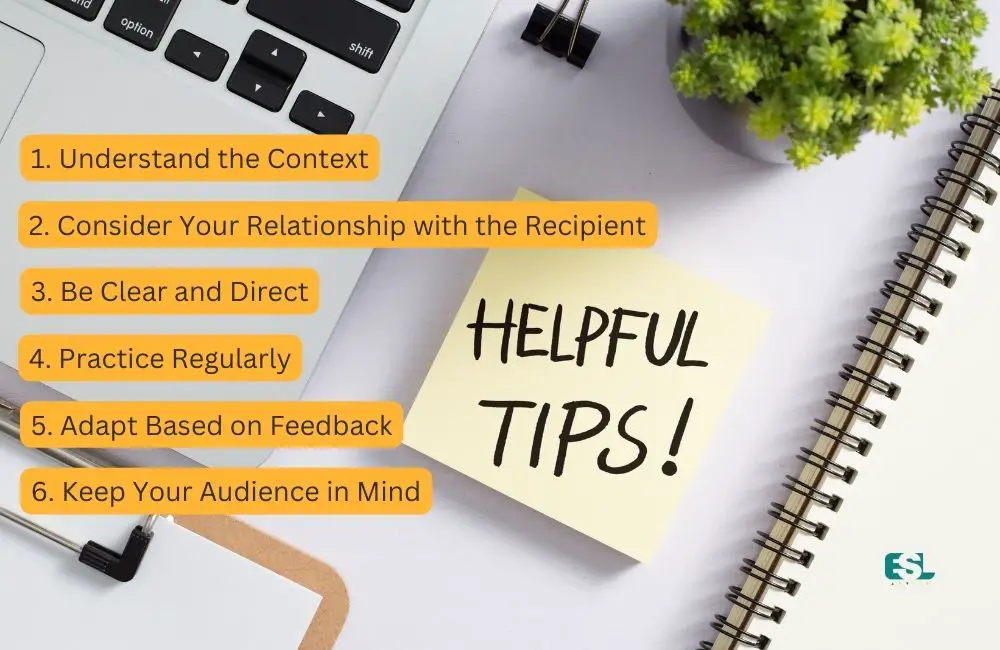“Follow up” is a phrase that is commonly used in professional and personal conversations, emails, and other forms of communication. It means to revisit, review, or continue a previous action, topic, or conversation. Although it is a frequently used term, knowing its synonyms can add variety to your language use. In this post, I’ll help you to learn different ways to say “follow up.”
“Follow up” can be alternatively expressed in numerous ways, such as “check back on,” “pursue further,” “get back to,” “review,” “continue on,” “circle back,” “revisit,” “carry on with, “double back,” and “come back to.” Each phrase varies slightly in tone and formality.
Are you looking for a book or a guide to help you learn and improve your English? You may try English Made Easy Volume One: A New ESL Approach: Learning English Through Pictures (Amazon Link).
Later in the post, we explore these phrases in detail, providing a range of example sentences to illustrate their usage. Additionally, we delve into practical tips on how to effectively use these alternate expressions in various contexts, ensuring clear and impactful communication.
Table of Contents
- 1. Check Back On
- 2. Pursue Further
- 3. Get Back To
- 4. Review
- 5. Continue On
- 6. Circle Back
- 7. Revisit
- 8. Carry On With
- 9. Double Back
- 10. Come Back To
- Tips on Using Alternate Expressions for “Follow Up”
- Sample Conversation: Using Alternatives to “Follow Up” in English
- In Conclusion
- 10 Frequently Asked Questions Related to Alternatives for “Follow Up” in English
As “follow up” is a crucial term often used in our interactions, repeatedly using it can lead to monotony. The English language offers a wealth of alternate expressions to keep our conversations fresh and engaging. We’ll explore the best 10 such alternatives, looking at their usage by context.

1. Check Back On
“Check back on” is generally used in informal settings or when the conversation has a friendly undertone. It signifies a commitment to return to a situation, person, or task in the future.
Example Sentences:
- I’ll check back on you tomorrow to see if you need any more assistance.
- I plan to check back on the progress of the project next week.
- Let me check back on that issue and see what we can do to resolve it.
- Can you check back on the team to ensure they have all the resources they need?
- I will check back on these figures and confirm their accuracy.
2. Pursue Further
“Pursue further” is a more formal alternative that expresses a strong determination to see a particular issue or task through to its resolution. It demonstrates a level of seriousness and professional commitment.
Example Sentences:
- We will pursue further details on this matter and let you know.
- I have to pursue this topic further before making a decision.
- Our team will pursue further investigation into the issue.
- The management decided to pursue the matter further to ensure fairness.
- We need to pursue the discussion further to reach a consensus.
3. Get Back To
“Get back to” is an informal way of expressing the intention to return to a topic or situation. It’s a promise to address an issue or return to a topic at a later point.
Example Sentences:
- I’ll get back to you with more information.
- Let me get back to you on that by tomorrow.
- We will get back to this topic after the break.
- I will get back to you once I have more information on this.
- Can we get back to the main point of the meeting?
4. Review
“Review” is another alternative to “follow up”, with a slightly formal tone. It signifies revisiting a topic, issue, or task to consider it carefully or reconsider it.
Example Sentences:
- We will review the proposal and respond by the end of the week.
- Our team is currently reviewing your application.
- I need to review the documents before signing them.
- Let’s review our project plan in the next meeting.
- After reviewing your performance, we have decided to promote you.
5. Continue On
“Continue on” refers to the process of persisting with a task or a discussion. This term is used when the conversation or action has not reached its end and there is more to be accomplished or discussed.
Example Sentences:
- We will continue on with this discussion tomorrow.
- Let’s continue on from where we left off in our last meeting.
- I’ll continue on with my tasks once I’ve had a short break.
- We need to continue on with our efforts to achieve the target.
- Let’s continue on with our journey despite the obstacles.
6. Circle Back
“Circle back” is a slightly casual term used when the speaker intends to revisit a topic or a matter later. It’s often used when a topic has been touched upon but requires further discussion at a later point.
Example Sentences:
- Let’s circle back to this point after we’ve discussed the other items on the agenda.
- We’ll circle back to your question at the end of the presentation.
- Can we circle back to this issue once we have more data?
- I’ll circle back to this topic after completing the current task.
- Let’s circle back to our original plan and see if there’s anything we missed.
7. Revisit
“Revisit” is a more formal term that denotes returning to a topic or issue after some time. This term is generally used in formal discussions or professional environments.
Example Sentences:
- We will revisit the budget proposal in our next meeting.
- It’s essential to revisit our goals every quarter to stay on track.
- We should revisit this issue once we have more clarity.
- Let’s revisit the topic once everyone has had a chance to think it over.
- We need to revisit our marketing strategy based on the latest market trends.
8. Carry On With
“Carry on with” indicates the continuation of a previously started conversation or task. It signifies the intent to persist with the current activity.
Example Sentences:
- After lunch, we’ll carry on with our discussion about the marketing plan.
- Let’s carry on with the work we started yesterday.
- I’ll carry on with the task once I’ve had my coffee.
- We need to carry on with the preparations for the event.
- Can we carry on with the meeting, or do we need a break?
9. Double Back
“Double back” is a casual phrase indicating the intent to return to a topic or issue. It’s often used when the speaker intends to return to a previously mentioned point in a conversation.
Example Sentences:
- I’ll double back to that point in a moment.
- Let’s double back to the first topic we discussed.
- We’ll double back to this issue after addressing the immediate concerns.
- I’ll double back to your suggestion once we’ve explored all the options.
- Can we double back to what you said earlier? I have a few thoughts on that.
10. Come Back To
“Come back to” denotes returning to a particular topic or issue. This phrase is often used when a discussion needs to be paused, with the intent to resume it later.
Example Sentences:
- Let’s come back to this topic tomorrow when we have more information.
- We can come back to this issue in our next meeting.
- I’ll come back to your question at the end of my presentation.
- Let’s come back to this point after a short break.
- We should come back to this discussion when everyone is present.
Tips on Using Alternate Expressions for “Follow Up”
Using alternate expressions effectively isn’t just about knowing a list of synonyms. It’s about understanding the context, the relationship between the parties involved, and the level of formality required. It’s about ensuring the message is clear and direct and adapting your language based on the feedback.

In this section, we’ll delve into some useful tips for mastering the use of alternate expressions for “follow up.” We’ll explore how to choose the right phrase based on the context and your relationship with the recipient, how to ensure your message is understood, and the importance of practicing and adapting your language use.
Whether you’re an English learner seeking to enhance your vocabulary or a seasoned speaker looking to add more variety to your language, these tips can help you communicate more effectively.
1. Understand the Context
The context of your conversation is crucial in determining which expression to use. Different scenarios call for different phrases. For instance, “check back on” exudes a casual tone, making it apt for informal conversations or situations. Conversely, “pursue further” exhibits a sense of formality and seriousness, making it a suitable choice for professional or official communications. The key is to match your language with the situation to ensure your message is appropriately received.
For example, in a friendly conversation with a coworker about their ongoing project, you might say, “I’ll check back on you next week to see how your project is going.”
2. Consider Your Relationship with the Recipient
The level of formality in your relationship with the recipient also plays a role in deciding the appropriate phrase. A more formal phrase like “review” or “pursue further” might be better if you’re communicating with a superior or someone you don’t know well. But when interacting with a friend or a close colleague, an informal phrase like “get back to” or “circle back” can convey your message in a friendlier tone.
For example, in an email to a senior executive, you might write, “We will review the proposal and respond by the end of the week.”
3. Be Clear and Direct
Regardless of which expression you use, clarity is paramount. Ensure your message is direct and easily understood to avoid confusion or miscommunication. Clearly state what you mean and what is expected from the other person.
For instance, when talking to your team, you might say, “We’ll continue on with this discussion tomorrow, so please come prepared with your thoughts and ideas.”
4. Practice Regularly
Regular practice will help you become more comfortable with these phrases. Try incorporating them in your day-to-day conversations and written communication. Over time, you’ll better understand when and how to use them effectively.
5. Adapt Based on Feedback
Keep an open mind and be ready to adapt based on the feedback you receive. If someone finds a certain phrase confusing, it’s a good idea to clarify your point and consider a simpler alternative in the future.
For example, if a colleague didn’t understand when you said you’ll “double back” to a point, you could say, “I meant I will return to that topic later. Sorry for any confusion.”
6. Keep Your Audience in Mind
Consider the language proficiency of your audience. If you’re speaking to someone whose first language isn’t English, they might not understand some of these phrases. In such cases, it’s better to use simple and clear language.
For instance, if you’re speaking to a non-native English speaker, instead of saying, “I’ll circle back to this point later,” you could say, “I will talk about this point again later.”
Sample Conversation: Using Alternatives to “Follow Up” in English
Situation: Lisa, a project manager, is discussing with her team member, Daniel, about checking the progress of a task with a client.
Lisa: Daniel, could you touch base with the client about the design changes?
Daniel: Sure, Lisa. I’ll check in with them first thing tomorrow morning.
Lisa: Great! Afterward, please get back to me with their feedback.
In Conclusion
“Follow up” is a common phrase in English, but many alternative ways exist to express the same idea. These different expressions can add richness and variety to your language use, making you a more effective communicator. Remember to consider the context and your relationship with the recipient and to practice regularly to improve your English skills.
10 Frequently Asked Questions Related to Alternatives for “Follow Up” in English
1. Why might I want to use alternatives to “follow up”?
Using a variety of phrases can make your communication sound more engaging and less repetitive, especially if you’re often checking on tasks or projects.
2. Are all these alternatives formal?
While many are suitable for formal settings, some might be more casual or colloquial. It’s essential to consider the context and the audience.
3. Can I use “circle back” in a professional setting?
Yes, “circle back” is commonly used in professional contexts to mean revisiting or checking on a topic later.
4. How can tone affect the way I use these alternatives?
Your tone can convey urgency, politeness, or casualness, regardless of the specific phrase used. Always be aware of your tone, especially in written communication.
5. How can I use “revisit” as an alternative?
“Revisit” implies looking at something again, often after some time has passed. E.g., “Let’s revisit this topic in our next meeting.”
6. Is “check back” the same as “check in”?
They’re similar, but “check back” often implies returning after a previous check, while “check in” can be an initial or routine check.
7. Can I use “see where things stand” in a casual conversation?
Yes, it’s a versatile phrase suitable for both formal and casual contexts.
8. How do I decide which alternative to use?
Consider the situation, the relationship with the person you’re speaking to, and the desired tone of the conversation.
9. Are these alternatives understood globally?
While many are universally understood, it’s always a good idea to be aware of regional or cultural nuances in communication.
10. Can I combine these alternatives in conversation?
Certainly! You might “touch base” initially and then “check back” later, for instance.






